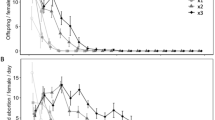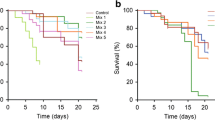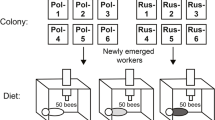Abstract
The effects of natural diet (brood, pollen, honey, and their various combinations), mating duration (1 day versus 2 days), female (F) to male (M) ratio (1F/1M, 2F/1M, and 1F/2M), and temperature (34 versus 27–29 °C) on ovary activation, mating success, and fecundity of small hive beetles (SHBs) were studied. Our results indicated that regardless of mating duration, (1) a diet of brood, pollen, and honey presented together supported the highest fecundity; (2) intake of protein-rich diets encouraged ovary activation and egg-laying; and (3) diet of honey alone did not encourage ovary activation, mating success, and egg-laying at room temperature. Regardless of the number of males available for mating, egg-laying varied through time. Overall, females that were presented with two males for a 5-day mating period had higher fecundity than females provided with one male or three male partners. High temperature accelerated ovary activation and egg-laying regardless of female to male ratio during a 15-h mating period. Knowledge of these factors that influence fecundity helps elucidate why SHBs are very successful pests of honey bees.



Similar content being viewed by others
References
Arbogast, R.T., Torto, B., Teal, P.E.A. (2010) Potential for population growth of the small hive beetle Aethina tumida (Coleoptera: Nitidulidae) on diets of pollen dough and oranges. Fla. Entomol. 93, 224–230
Bownes, M. (1986) Expression of the genes coding for vitellogenin (yolk protein). Ann. Rev. Entomol. 31, 507–531
Clay, H (2006) Small hive beetle in Canada. Hivelights 19, 14–16
Connor, L. (2011) Wipe out! The big island in crisis. Bee Cult. 139, 56–60
Crane, E. (1990). Bees and beekeeping: Science, Practice and World Resources. Cornstock Publ., Ithaca, NY., USA
de Guzman, L.I., Frake, A.M. (2007) Temperature affects Aethina tumida (Coleoptera: Nitidulidae) development. J. Apic. Res. 46, 88–93
de Guzman, L.I., Frake, A.M., Rinderer, T.E. (2008) Detection and removal of brood infested with eggs and larvae of small hive beetles (Aethina tumida Murray) by Russian and Italian honey bees. J. Apic. Res. 47, 216–221
de Guzman, L.I., Frake, A.M., Rinderer, T.E. (2012) Marking small hive beetles with thoracic notching: Effects on longevity, flight ability and fecundity. Apidologie 43, 425–431
Ellis, J.D., Neumann, P., Hepburn, H.R., Elzen, P.J. (2002a) Longevity and reproductive success of Aethina tumida (Coleoptera: Nitidulidae) fed different natural diets. J. Econ. Entomol. 95, 902–907
Ellis, J., Pirk, C., Hepburn, H., Kastberger, G., Elzen, P. (2002b) Small hive beetles survive in honeybee prisons by behavioural mimicry. Naturwissenschaften 89, 326–328
Ellis, J.D., Richard, C.S., Hepburn, H.R., Elzen, P.J. (2003) Oviposition by small hive beetles elicits hygienic responses from Cape honey bees. Naturwissenschaften 90, 532–535
Ellis, J.D., Delaplane, K.S., Richard, C.S., Hepburn, H.R., Berry, J.A., Elzen, P.J. (2004) Hygienic behaviour of Cape and European Apis mellifera (Hymenoptera: Apidae) toward Aethina tumida (Coleoptera: Nitidulidae) eggs oviposited in sealed bee brood. Ann. Entomol. Soc. Amer. 97, 860–864
Ellis, J.D., Hepburn, H.R. (2006) An ecological digest of the small hive beetle (Aethina tumida), a symbiont in honey bee colonies (Apis mellifera). Insectes Soc. 53, 8–19
Ellis, J.D., Delaplane, K.S. (2008) Small hive beetle (Aethina tumida) oviposition behaviour in sealed brood cells with notes on the removal of the cell contents by European honey bees (Apis mellifera). J. Apic. Res. 47, 210–215
Gillespie, P., Staples, J., King, C., Fletcher, M.J., Dominiak, B.C. (2003) Small hive beetle, Aethina tumida (Murray) (Coleoptera: Nitidulidae) in New South Wales. General and Applied Entomology 32: 5–7
Haydak, M.H. (1970) Honey bee nutrition. Ann. Rev. Entomol. 15, 143–156
Herbert, E.W., Shimanuki, H. (1978) Chemical composition and nutritive value of bee-collected and bee-stored pollen. Apidologie 9, 33–40
Keller, J.J. (2002) Testing effects of alternative diets on reproduction rates of the small hive beetle, Aethina tumida. Ms Thesis North Carolina State University. 55 pp
Lundie, A.E. (1940) The small hive beetle. Aethina tumida. Science Bulletin, Department of Agriculture and Forestry, Union of South Africa. 220
Meikle, W.G., Patt, J.M. (2011) The effects of temperature, diet, and other factors on development, survivorship, and oviposition of Aethina tumida (Coleoptera: Nitidulidae). J. Econ. Entomol. 104, 753–763
Neumann, P., Pirk, C.W.W., Hepburn, H.R., Elzen, P.J., Baxter, J.R. (2001a) Laboratory rearing of small hive beetle, Aethina tumida (Coleoptera: Nitidulidae). J. Apic. Res. 40, 111–112
Neumann, P., Pirk, C., Hepburn, H., Solbrig, A., Ratnieks, F., Elzen, P., Baxter, J. (2001b) Social encapsulation of beetle parasites by Cape honeybee colonies (Apis mellifera capensis Esch.). Naturwissenschaften 88, 214–216
Neumann, P., Evans, J.D., Pettis, J.S., Pirk, C.W.W., Schaefer, M.O., Tanner, G., Ellis, J.D. (2013) Standard methods for small hive beetle research. J. Apic. Res. 52, no. 4, DOI: 10.3896/IBRA.1.52.4.19
Palmer, A., Oldroyd, B.P. (2000) Evolution of multiple mating in the genus Apis. Apidologie 31, 235–248
Pernal, S.F., Currie, R.W. (2000) Pollen quality of fresh and 1-year-old single pollen diets for worker honey bees. Apidologie 31, 387–409
SAS Institute, Inc. (2008) SAS User’s Guide, Version 8.2, SAS Institute, Cary, NC
Schmolke, M.D. (1974) A Study of Aethina tumida: The Small Hive Beetle. University of Rhodesia (Zimbabwe), Certificate in Field Ecology Project Report, Salisbury (Harare). 178 pp
Spiewok, S., Neumann, P. (2006) The impact of recent queenloss and colony phenotype on the removal of small hive beetle (Aethina tumida Murray) eggs and larvae by African honey bee colonies (Apis mellifera capensis Esch.). J. Insect Behav 19, 601–611
Steiner, J., Dittmann, F., Rosenkranz, P., Engels, W. (1994) The first gonocycle of the parasitic mite (Varroa jacobsoni) in relation to preimaginal development of its host, the honey bee). Invertebr. Rep. Develop. 25, 175–183
Acknowledgments
We thank J.A. Stelzer, J. Wales, and G. Delatte for their technical assistance.
Author information
Authors and Affiliations
Corresponding author
Additional information
Les effets du régime alimentaire, de la durée de l’accouplement, du ratio femelle/mâle et de la température sur l’activation ovarienne, le succès de l’accouplement et la fécondité d’ Aethina tumida
petit coléoptère des ruches / succès reproducteur / partenaire sexuel / ennemi de la ruche
Auswirkungen der Diät, Paarungsdauer, des Geschlechterverhältnisses und der Temperatur auf die Ovaraktivierung, den Parrungserfolg und die Fekundität von Aethina tumida
Aethina tumida / Fekundität / Ovaraktivierung / Paarungsdauer / Paarungspartner
Manuscript editor: Stan Schneider
Rights and permissions
About this article
Cite this article
de Guzman, L.I., Rinderer, T.E. & Frake, A.M. The effects of diet, mating duration, female to male ratios, and temperature on ovary activation, mating success, and fecundity of Aethina tumida . Apidologie 46, 326–336 (2015). https://doi.org/10.1007/s13592-014-0325-y
Received:
Revised:
Accepted:
Published:
Issue Date:
DOI: https://doi.org/10.1007/s13592-014-0325-y




